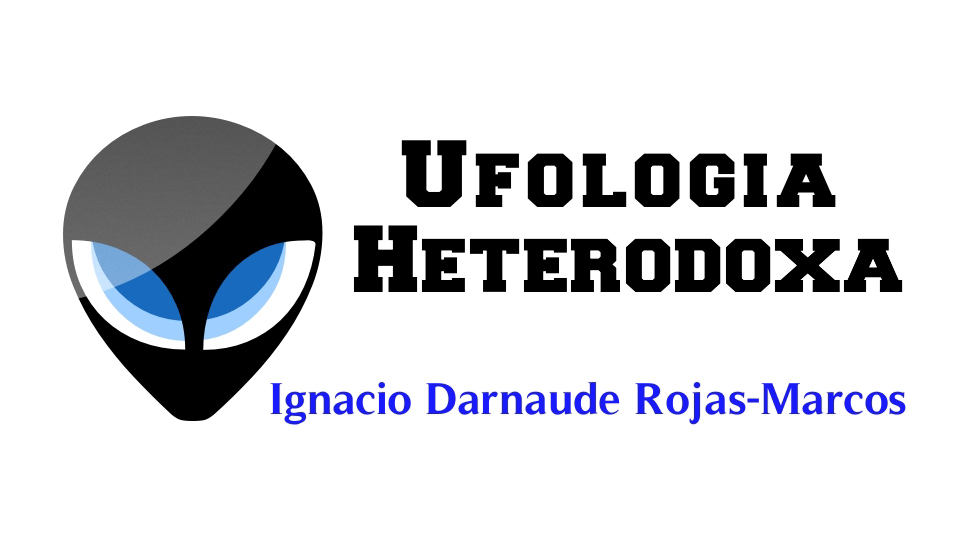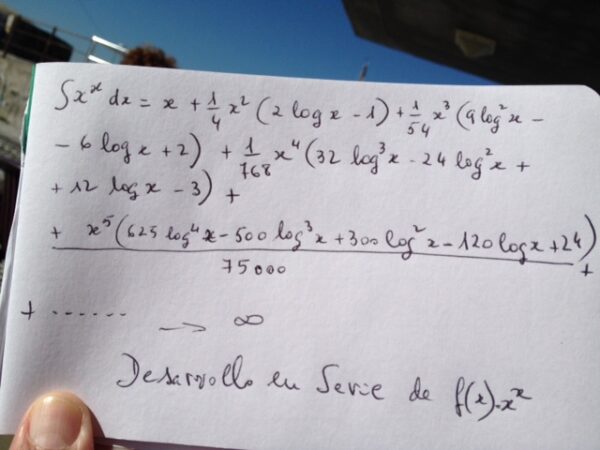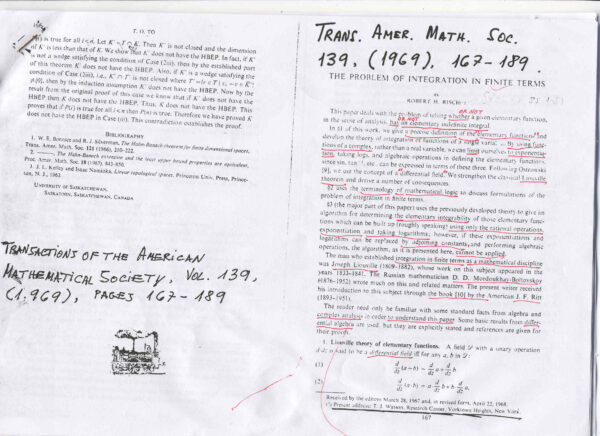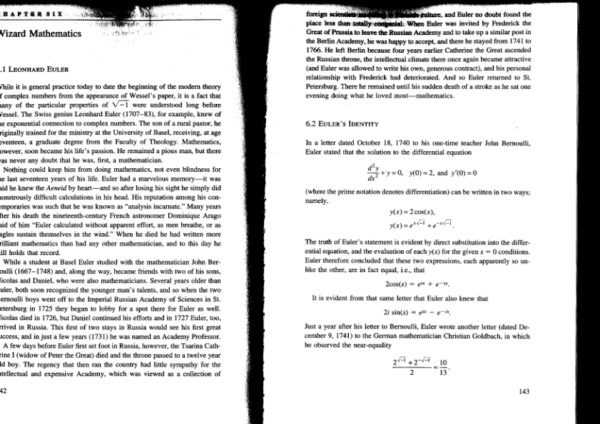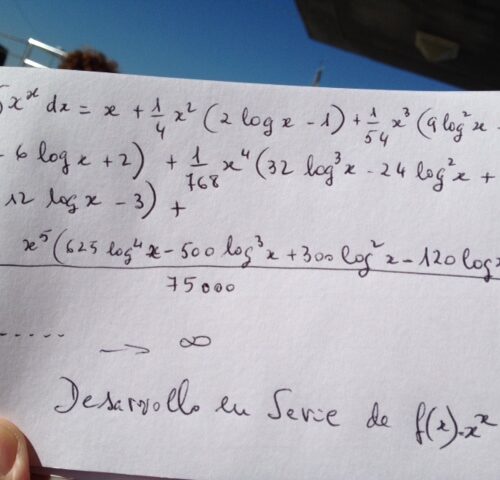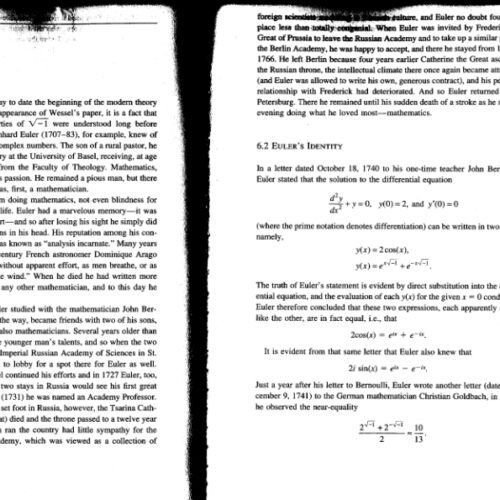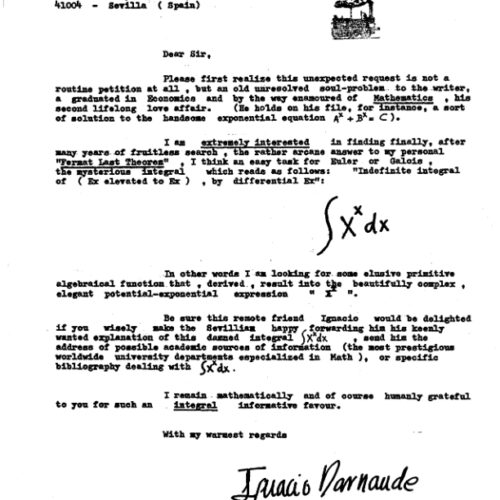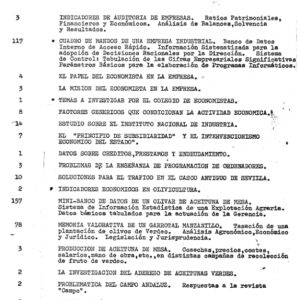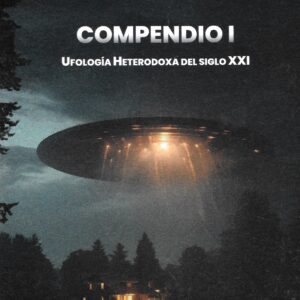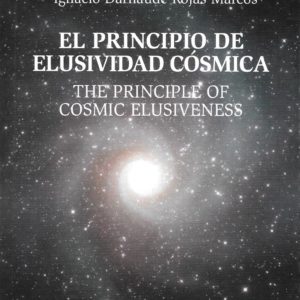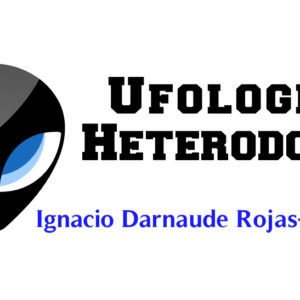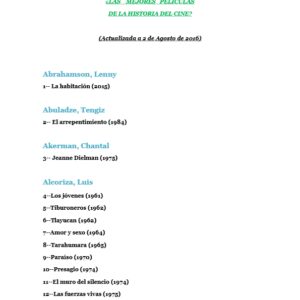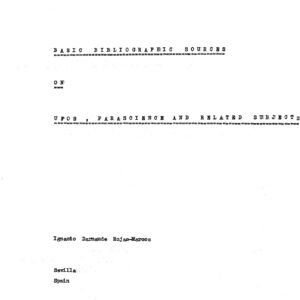Integral de X elevado a X
- Descripción
Descripción
Integral de X elevado a X
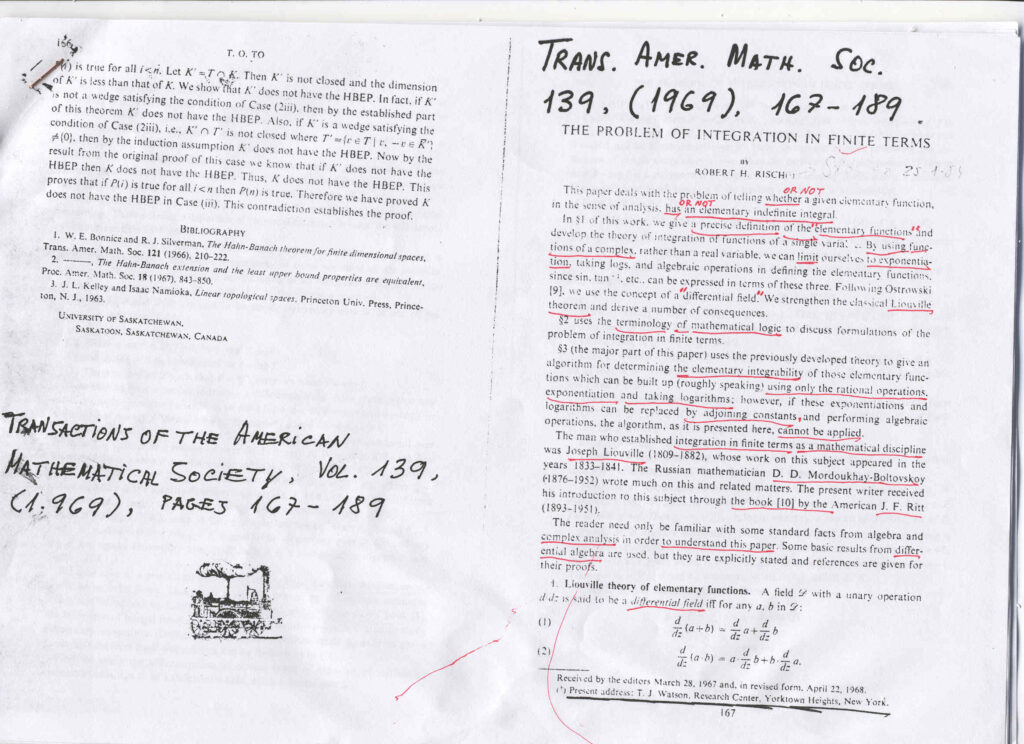
[This post updates a 1995 post by Wiener also available at this site. –djr]
==============================================================================
From: weemba@sagi.wistar.upenn.edu (Matthew P Wiener)
Subject: Re: Repost: Integral of x^x
Date: 30 Nov 1997 20:42:28 GMT
Newsgroups: sci.math
Keywords: Functions without elementary antiderivative
What’s the antiderivative of exp(-x^2)? of sin(x)/x? of x^x?
————————————————————————
These, and some similar problems, can’t be done.
More precisely, consider the notion of «elementary function». These are
the functions that can be expressed in terms of exponentals and logarithms,
via the usual algebraic processes, including the solving (with or without
radicals) of polynomials. Since the trigonometric functions and their
inverses can be expressed in terms of exponentials and logarithms using
the complex numbers C, these too are elementary.
The elementary functions are, so to speak, the «precalculus functions».
Then there is a theorem that says certain elementary functions do not
have an elementary antiderivative. They still have antiderivatives,
but «they can’t be done». The more common ones get their own names.
Up to some scaling factors, «erf» is the antiderivative of exp(-x^2)
and «Si» is the antiderivative of sin(x)/x, and so on.
————————————————————————
For those with a little bit of undergraduate algebra, we sketch a proof
of these, and a few others, using the notion of a differential field.
These are fields (F,+,.,1,0) equipped with a derivation, that is, a
unary operator ‘ satisifying (a+b)’=a’+b’ and (a.b)’=a.b’+a’.b. Given
a differential field F, there is a subfield Con(F)={a:a’=0}, called the
_constants_ of F. We let I(f) denote an antiderivative. We ignore +cs.
Most examples in practice are subfields of M, the meromorphic functions
on C (or some domain). Because of uniqueness of analytic extensions, one
rarely has to specify the precise domain.
Given differential fields F and G, with F a subfield of G, one calls G
an algebraic extension of F if G is a finite field extension of F.
One calls G a logarithmic extension of F if G=F(t) for some transcendental
t that satisfies t’=s’/s, some s in F. We may think of t as log s, but
note that we are not actually talking about a logarithm function on F. We
simply have a new element with the right derivative. Other «logarithms»
would have to be adjoined as needed.
Similarly, one calls G an exponential extension of F if G=F(t) for some
transcendental t that satisfies t’=t.s’, some s in F. Again, we may
think of t as exp s, but there is no actual exponential function on F.
Finally, we call G an elementary differential extension of F if there is
a finite chain of subfields from F to G, each an algebraic, logarithmic,
or exponential extension of the next smaller field.
The following theorem, in the special case of M, is due to Liouville. The
algebraic generality is due to Rosenlicht. More powerful theorems have
been proven by Risch, Davenport, and others, and are at the heart of
symbolic integration packages.
A short proof, accessible to those with a solid background in undergraduate
algebra, can be found in Rosenlicht’s AMM paper (see references). It is
probably easier to master its applications first, which often use similar
techniques, and then learn the proof.
————————————————————————
MAIN THEOREM. Let F,G be differential fields, let a be in F, let y be in G,
and suppose y’=a and G is an elementary differential extension field of F,
and Con(F)=Con(G). Then there exist c_1,…,c_n in Con(F), u_1,…,u_n, v
in F such that
u_1′ u_n’
a = c_1 — + … + c_n — + v’.
u_1 u_n
That is, the only functions that have elementary antiderivatives are the
ones that have this very specific form. In words, elementary integrals
always consist of a function at the same algebraic «complexity» level as
the starting function (the v), along with the logarithms of functions at
the same algebraic «complexity» level (the u_i ‘s).
————————————————————————
This is a very useful theorem for proving non-integrability. Because
this topic is of interest, but it is only written up in bits and pieces,
I give numerous examples. (Since the original version of this FAQ from
way back when, two how-to-work-it write-ups have appeared. See Fitt &
Hoare and Marchisotto & Zakeri in the references.)
In the usual case, F,G are subfields of M, so Con(F)=Con(G) always holds,
both being C. As a side comment, we remark that this equality is necessary.
Over R(x), 1/(1+x^2) has an elementary antiderivative, but none of the above
form.
We first apply this theorem to the case of integrating f.exp(g), with f
and g rational functions. If g=0, this is just f, which can be integrated
via partial fractions. So assume g is nonzero. Let t=exp(g), so t’=g’t.
Since g is not zero, it has a pole somewhere (perhaps out at infinity),
so exp(g) has an essential singularity, and thus t is transcendental over
C(z). Let F=C(z)(t), and let G be an elementary differential extension
containing an antiderivative for f.t.
Then Liouville’s theorem applies, so we can write
u_1′ u_n’
f.t = c_1 — + … + c_n — + v’
u_1 u_n
with the c_i constants and the u_i and v in F. Each u_i is a ratio of
two C(z)[t] polynomials, U/V say. But (U/V)’/(U/V)=U’/U-V’/V (quotient
rule), so we may rewrite the above and assume each u_i is in C(z)[t].
And if any u_i=U.V factors, then (U.V)’/(U.V)=U’/U+V’/V and so we can
further assume each u_i is irreducible over C(z).
What does a typical u’/u look like? For example, consider the case of u
quadratic in t. If A,B,C are rational functions in C(z), then A’,B’,C’
are also rational functions in C(z) and
(A.t^2+B.t+C)’ A’.t^2 + 2At(gt) + B’.t + B.(gt) + C’
————- = ————————————-
A.t^2+B.t+C A.t^2 + B.t + C
(A’+2Ag).t^2 + (B’+Bg).t + C’
= —————————– .
A.t^2 + B.t + C
(Note that contrary to the usual situation, the degree of a polynomial
in t stays the same after differentiation. That is because we are
taking derivatives with respect to z, not t. If we write this out
explicitly, we get (t^n)’ = exp(ng)’ = ng’.exp(ng) = ng’.t^n.)
In general, each u’/u is a ratio of polynomials of the same degree. We
can, by doing one step of a long division, also write it as D+R/u, for
some D in C(z) and R in C(z)[t], with deg(R)<deg(u).
By taking partial fractions, we can write v as a sum of a C(z)[t] polynomial
and some fractions P/Q^n with deg(P)<deg(Q), Q irreducible, with each P,Q
in C(z)[t]. v’ will thus be a polynomial plus partial fraction like terms.
Somehow, this is supposed to come out to just f.t. By the uniqueness of
partial fraction decompositions, all terms other than multiples of t add
up to 0. Only the polynomial part of v can contribute to f.t, and this
must be a monomial over C(z). So f.t=(h.t)’, for some rational h. (The
temptation to assert v=h.t here is incorrect, as there could be some C(z)
term, cancelled by u’/u terms. We only need to identify the terms in v
that contribute to f.t, so this does not matter.)
Summarizing, if f.exp(g) has an elementary antiderivative, with f and g
rational functions, g nonzero, then it is of the form h.exp(g), with h
rational.
We work out particular examples, of this and related applications. A
bracketed function can be reduced to the specified example by a change
of variables.
** exp(z^2) [sqrt(z).exp(z),exp(z)/sqrt(z)]
Let h.exp(z^2) be its antiderivative. Then h’+2zh=1. Solving this ODE
gives h=exp(-z^2)*I(exp(z^2)), which has no pole (except perhaps at
infinity), so h, if rational, must be a polynomial. But the derivative
of h cannot cancel the leading power of 2zh, contradiction.
** exp(z)/z [exp(exp(z)),1/log(z)]
Let h.exp(z) be an antiderivative. Then h’+h=1/z. I know of two quick
ways to prove that h is not rational.
One can explicitly solve the first order ODE (getting exp(-z)*I(exp(z)/z)),
and then notice that the solution has a logarithmic singularity at zero.
For example, h(z)->oo but sqrt(z)*h(z)->0 as z->0. No rational function
does this.
Or one can assume h has a partial fraction decomposition. Obviously no h’
term will give 1/z, so 1/z must be present in h already. But (1/z)’=-1/z^2,
and this is part of h’. So there is a 1/z^2 in h to cancel this. But
(1/z^2) is -2/z^3, and this is again part of h’. And again, something
in h cancels this, etc etc etc. This infinite regression is impossible.
** sin(z)/z [sin(exp(z))]
** sin(z^2) [sqrt(z).sin(z),sin(z)/sqrt(z)]
Since sin(z)=%[exp(iz)-exp(-iz)] (where %=1/2i), we merely rework the
above f.exp(g) result. Let f be rational, let t=exp(iz) (so t’/t=i) and
let T=exp(iz^2) (so T’/T=2iz) and we want an antiderivative of either
%f.(t-1/t) or T-1/T. For the former, the same partial fraction results
still apply in identifying %f.t=(h.t)’=(h’+ih).t, which can’t happen, as
above. In the case of sin(z^2), we want %T=(h.T)’=(h’+2izh).T, and again,
this can’t happen, as above.
Although done, we push this analysis further in the f.sin(z)/z case, as
there are extra terms hanging around. This time around, the conclusion
gives an additional k/t term inside v, so we have -%f/t=(k/t)’=(k’-ik)/t.
So the antiderivative of %f*(t-1/t) is h.t+k/t.
If f is even and real, then h and k (like t=exp(iz) and 1/t=exp(-iz)) are
parity flips of each other, so (as expected) the antiderivative is even.
Letting C=cos(z), S=sin(z), h=H+iF and k=K+iG, the real (and only) part
of the antiderivative of f is (HC-FS)+(KC+GS)=(H+K)C+(G-F)S. So over
the reals, we find that the antiderivative of (rational even).sin(x) is
of the form (rational even).cos(x)+ (rational odd).sin(x).
A similar result holds for (odd).sin(x), (even).cos(x), (odd).cos(x). And
since a rational function is the sum of its (rational) even and odd parts,
(rational).sin integrates to (rational).sin + (rational).cos, or not at all.
Let’s backtrack, and apply this to sin(x)/x directly, using reals only.
If it has an elementary antiderivative, it must be of the form E.S+O.C.
Taking derivatives gives (E’-O).S+(E+O’).C. As with partial fractions,
we have a unique R(x)[S,C] representation here (this is a bit tricky,
as S^2=1-C^2: this step can be proven directly or via solving for t,1/t
coefficients over C). So E’-O=1/x and E+O’=0, or O»+O=-1/x. Expressing
O in partial fraction form, it is clear only (-1/x) in O can contribute
a -1/x. So there is a -2/x^3 term in O», so there is a 2/x^3 term in
O to cancel it, and so on, an infinite regress. Hence, there is no such
rational O.
** arcsin(z)/z [z.tan(z)]
We consider the case where F=C(z,Z)(t) as a subfield of the meromorphic
functions on some domain, where z is the identify function, Z=sqrt(1-z^2),
and t=arcsin z. Then Z’=-z/Z, and t’=1/Z. We ask in the main theorem
result if this can happen with a=t/z and some field G. t is transcendental
over C(z,Z), since it has infinite branch points.
So we consider the more general situation of f(z).arcsin(z) where f(z)
is rational in z and sqrt(1-z^2). By letting z=2w/(1+w^2), note that
members of C(z,Z) are always elementarily integrable.
Because x^2+y^2-1 is irreducible, C[x,y]/(x^2+y^2-1) is an integral domain,
C(z,Z) is isomorphic to its field of quotients in the obvious manner, and
C(z,Z)[t] is a UFD whose field of quotients is amenable to partial fraction
analysis in the variable t. What follows takes place at times in various
z-algebraic extensions of C(z,Z) (which may not have unique factorization),
but the terms must combine to give something in C(z,Z)(t), where partial
fraction decompositions are unique, and hence the t term will be as claimed.
Thus, if we can integrate f(z).arcsin(z), we have f.t = sum of (u’/u)s
and v’, by the main theorem.
The u terms can, by logarithmic differentiation in the appropriate
algebraic extension field (recall that roots are analytic functions of
the coefficients, and t is transcendental over C(z,Z)), be assumed to
all be linear t+r, with r algebraic over z. Then u’/u=(1/Z+r’)/(t+r).
When we combine such terms back in C(z,Z), they don’t form a t term
(nor any higher power of t, nor a constant).
Partial fraction decomposition of v gives us a polynomial in t, with
coefficients in C(z,Z), plus multiples of powers of linear t terms.
The latter don’t contribute to a t term, as above.
If the polynomial is linear or quadratic, say v=g.t^2 + h.t + k, then
v’=g’.t^2 + (2g/Z+h’).t + (h/Z+k’). Nothing can cancel the g’, so g
is just a constant c. Then 2c/Z+h’=f or I(f.t)=2c.t+I(h’.t). The
I(h’.t) can be integrated by parts. So the antiderivative works out
to c.(arcsin(z))^2 + h(z).arcsin(z) – I(h(z)/sqrt(1-z^2)), and as
observed above, the latter is elementary.
If the polynomial is cubic or higher, let v=A.t^n+B.t^(n-1)+…., then
v’=A’.t^n + (n.A/Z+B’).t^(n-1) +…. A must be a constant c. But then
nc/Z+B’=0, so B=-nct, contradicting B being in C(z,Z).
In particular, since 1/z + c/sqrt(1-z^2) does not have a rational in
«z and/or sqrt(1-z^2)» antiderivative, arcsin(z)/z does not have an
elementary integral.
** z^z
In this case, let F=C(z,l)(t), the field of rational functions in z,l,t,
where l=log z and t=exp(z.l)=z^z. Note that z,l,t are algebraically
independent. Then t’=(l+1).t, so for a=t in the main theorem, the
partial fraction analysis shows that the only possibility is for
v=w.t+… to be the source of the t term on the left, with w in C(z,l).
So this means, equating t coefficients, 1=w’+(l+1)w. This is a first
order ODE, whose solution is w=I(z^z)/z^z. So we must prove that no
such w exists in C(z,l). So suppose w=P/Q, with P,Q in C[z,l] and no
common factors. Then z^z=(z^z*P/Q)’=z^z*[(1+l)PQ+P’Q-PQ’]/Q^2, or
Q^2=(1+l)PQ+P’Q-PQ’. So Q|Q’, meaning Q is a constant, which we may
assume to be one. So we have it down to P’+P+lP=1.
Let P=Sum[P_i l^i], with P_i, i=0…n in C[z]. But then in our equation,
there’s a dangling P_n l^(n+1) term, a contradiction.
————————————————————————
On a slight tangent, this theorem of Liouville will not tell you that
Bessel functions are not elementary, since they are defined by second
order ODEs. This can be proven using differential Galois theory. A
variant of the above theorem of Liouville, with a different normal form,
does show however that J_0 cannot be integrated in terms of elementary
methods augmented with Bessel functions.
========================================================================
What follows is a fairly complete sketch of the proof of the Main Theorem.
First, I just state some easy (if you’ve had Galois Theory 101) lemmas.
Throughout the lemmas F is a differential field, and t is transcendental
over F.
Lemma 1: If K is an algebraic extension field of F, then there exists a
unique way to extend the derivation map from F to K so as to make K into
a differential field.
Lemma 2: If K=F(t) is a differential field with derivation extending F’s,
and t’ is in F, then for any polynomial f(t) in F[t], f(t)’ is a polynomial
in F[t] of the same degree (if the leading coefficient is not in Con(F))
or of degree one less (if the leading coefficient is in Con(F)).
Lemma 3: If K=F(t) is a differential field with derivation extending F’s,
and t’/t is in F, then for any a in F, n a positive integer, there exists
h in F such that (a*t^n)’=h*t^n. More generally, if f(t) is any polynomial
in F[t], then f(t)’ is of the same degree as f(t), and is a multiple of
f(t) iff f(t) is a monomial.
These are all fairly elementary. For example, (a*t^n)’=(a’+at’/t)*t^n
in lemma 3. The final ‘iff’ in lemma 3 is where transcendence of t comes
in. Lemma 1 in the usual case of subfields of M is an easy consequence
of the implicit function theorem.
————————————————————————–
MAIN THEOREM. Let F,G be differential fields, let a be in F, let y be in G,
and suppose y’=a and G is an elementary differential extension field of F,
and Con(F)=Con(G). Then there exist c_1,…,c_n in Con(F), u_1,…,u_n, v
in F such that
u_1′ u_n’
a = c_1 — + … + c_n — + v’.
u_1 u_n
In other words, the only functions that have elementary antiderivatives
are the ones that have this very specific form.
————————————————————————
Proof:
By assumption there exists a finite chain of fields connecting F to G
such that the extension from one field to the next is given by performing
an algebraic, logarithmic, or exponential extension. We show that if the
form (*) can be satisfied with values in F2, and F2 is one of the three
kinds of allowable extensions of F1, then the form (*) can be satisfied
in F1. The form (*) is obviously satisfied in G: let all the c’s be 0, the
u’s be 1, and let v be the original y for which y’=a. Thus, if the form
(*) can be pulled down one field, we will be able to pull it down to F,
and the theorem holds.
So we may assume without loss of generality that G=F(t).
Case 1: t is algebraic over F. Say t is of degree k. Then there are
polynomials U_i and V such that U_i(t)=u_i and V(t)=v. So we have
U_1(t)’ U_n(t)’
a = c_1 —— + … + c_n —— + V(t)’.
U_1(t) U_n(t)
Now, by the uniqueness of extensions of derivatives in the algebraic case,
we may replace t by any of its conjugates t_1,…, t_k, and the same equation
holds. In other words, because a is in F, it is fixed under the Galois
automorphisms. Summing up over the conjugates, and converting the U’/U
terms into products using logarithmic differentiation, we have
[U_1(t_1)*…*U_1(t_k)]’
k a = c_1 ———————– + … + [V(t_1)+…+V(t_k)]’.
U_1(t_1)*…*U_n(t_k)
But the expressions in […] are symmetric polynomials in t_i, and as
they are polynomials with coefficients in F, the resulting expressions
are in F. So dividing by k gives us (*) holding in F.
Case 2: t is logarithmic over F. Because of logarithmic differentiation
we may assume that the u’s are monic and irreducible in t and distinct.
Furthermore, we may assume v has been decomposed into partial fractions.
The fractions can only be of the form f/g^j, where deg(f)<def(g) and g
is monic irreducible. The fact that no terms outside of F appear on the
left hand side of (*), namely just a appears, means a lot of cancellation
must be occuring.
Let t’=s’/s, for some s in F. If f(t) is monic in F[t], then f(t)’ is also
in F[t], of one less degree. Thus f(t) does not divide f(t)’. In particular,
all the u’/u terms are in lowest terms already. In the f/g^j terms in v,
we have a g^(j+1) denominator contribution in v’ of the form -jfg’/g^(j+1).
But g doesn’t divide fg’, so no cancellation occurs. But no u’/u term can
cancel, as the u’s are irreducible, and no (**)/g^(j+1) term appears in
a, because a is a member of F. Thus no f/g^j term occurs at all in v. But
then none of the u’s can be outside of F, since nothing can cancel them.
(Remember the u’s are distinct, monic, and irreducible.) Thus each of the
u’s is in F already, and v is a polynomial. But v’ = a – expression in u’s,
so v’ is in F also. Thus v = b t + c for some b in con(F), c in F, by lemma
2. Then
u_1′ u_n’ s’
a = c_1 — + … + c_n — + b — + c’
u_1 u_n s
is the desired form. So case 2 holds.
Case 3: t is exponential over F. So let t’/t=s’ for some s in F. As in
case 2 above, we may assume all the u’s are monic, irreducible, and distinct
and put v in partial fraction decomposition form. Indeed the argument is
identical as in case 2 until we try to conclude what form v is. Here lemma
3 tells us that v is a finite sum of terms b*t^j where each coefficient is
in F. Each of the u’s is also in F, with the possible exception that one
of them may be t. Thus every u’/u term is in F, so again we conclude v’
is in F. By lemma 3, v is in F. So if every u is in F, a is in the desired
form. Otherwise, one of the u’s, say u_n, is actually t, then
u_1′
a = c_1 — + … + (c_n s + v)’
u_1
is the desired form. So case 3 holds.
========================================================================
References:
A D Fitt & G T Q Hoare «The closed-form integration of arbitrary functions»,
MATHEMATICAL GAZETTE (1993), pp 227-236.
I Kaplansky INTRODUCTION TO DIFFERENTIAL ALGEBRA (Hermann, 1957)
E R Kolchin DIFFERENTIAL ALGEBRA AND ALGEBRAIC GROUPS (Academic Press, 1973)
A R Magid LECTURES ON DIFFERENTIAL GALOIS THEORY (AMS, 1994)
E Marchisotto & G Zakeri «An invitation to integration in finite terms»,
COLLEGE MATHEMATICS JOURNAL (1994), pp 295-308.
J F Ritt INTEGRATION IN FINITE TERMS (Columbia, 1948).
J F Ritt DIFFERENTIAL ALGEBRA (AMS, 1950).
M Rosenlicht «Liouville’s theorem on functions with elementary integrals»,
PACIFIC JOURNAL OF MATHEMATICS (1968), pp 153-161.
M Rosenlicht «Integration in finite terms», AMERICAN MATHEMATICS MONTHLY,
(1972), pp 963-972.
G N Watson A TREATISE ON THE THEORY OF BESSEL FUNCTIONS (Cambridge, 1962).
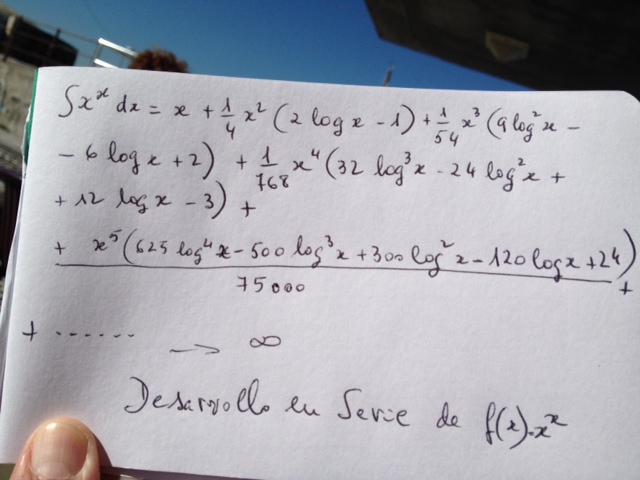
Integral X elevado a x Integral SX elevado a x,Nahin

Ignacio Darnaude Rojas‑Marcos
Cabeza del Rey Don Pedro , 9 ( 2º B )
41004 ‑ Sevilla ( Spain )
Dear Sirs ,
Please first realize this unexpectod request is not a routine petition at all , but an old unresolved soul‑problem to the writer , a graduated in Economics and by the way enamoured of Mathematics , his second lifelong love affair. ( He is , too , fallen in love with some imaginable sort of solution to the handsome exponential equation “A elevated to x plus B elevated to x = C elevated to x” ).
I am extremely interested in finding finally, after many years of fruitless search , the rather arcane answer to my personal “Fermat Last Theorem” , I think an easy task for Euler or Galois : the mysterious integral
which reads as follows :
«Indefinite integral of X elevated to x by differential x» :
x
S X dx
In other words I am looking for some elusive primitive algebraical function that , derived , result into a beautifully complex and elegant potential‑exponential expression : X elevated to x.
Be sure this remote friend Ignacio would be delighted if you wisely make the Sevillian happy by means of forwarding him his keenly wanted explanation of this damned integral , send him the address of possible academic sources of information ( the most prestigious worldwide university departments especialized in Math ) , or specific bibliography dealing with the above mentioned “Integral of X elevetad to x differential x”
I remain mathematically and of course humanly grateful to you for such an integral informative favour.
With my warmest regards
INTEGRAL S X^x dx , TEOREMAS DE EDGAR Y WIENER
The Math Forum
sci.math
< previous
||
Message: Repost: Integral of x^x
What’s the antiderivative of exp(-x^2)? , of sin(x)/x?, of x^x?
————————————————————————
These, and some similar problems, can’t be done.
More precisely, consider the notion of «elementary function». These are
the functions that can be expressed in terms of exponentals and
logarithms,
via the usual algebraic processes, including the solving (with or
without
radicals) of polynomials. Since the trigonometric functions and their
inverses can be expressed in terms of exponentials and logarithms using
the complex numbers C, these too are elementary.
The elementary functions are, so to speak, the «precalculus functions».
Then there is a theorem that says certain elementary functions do not
have an elementary antiderivative. They still have antiderivatives,
but «they can’t be done». The more common ones get their own names.
Up to some scaling factors, «erf» is the antiderivative of exp(-x^2)
and «Si» is the antiderivative of sin(x)/x, and so on.
————————————————————————
For those with a little bit of undergraduate algebra, we sketch a proof
of these, and a few others, using the notion of a differential field.
These are fields (F,+,.,1,0) equipped with a derivation, that is, a
unary operator ‘ satisifying (a+b)’=a’+b’ and (a.b)’=a.b’+a’.b. Given
a differential field F, there is a subfield Con(F)={a:a’=0}, called the
_constants_ of F. We let I(f) denote an antiderivative. We ignore +cs.
Most examples in practice are subfields of M, the meromorphic functions
on C (or some domain). Because of uniqueness of analytic extensions,
one
rarely has to specify the precise domain.
Given differential fields F and G, with F a subfield of G, one calls G
an algebraic extension of F if G is a finite field extension of F.
One calls G a logarithmic extension of F if G=F(t) for some
transcendental
t that satisfies t’=s’/s, some s in F. We may think of t as log s, but
note that we are not actually talking about a logarithm function on F.
We
simply have a new element with the right derivative. Other «logarithms»
would have to be adjoined as needed.
Similarly, one calls G an exponential extension of F if G=F(t) for some
transcendental t that satisfies t’=t.s’, some s in F. Again, we may
think of t as exp s, but there is no actual exponential function on F.
Finally, we call G an elementary differential extension of F if there is
a finite chain of subfields from F to G, each an algebraic, logarithmic,
or exponential extension of the next smaller field.
The following theorem, in the special case of M, is due to Liouville.
The
algebraic generality is due to Rosenlicht. More powerful theorems have
been proven by Risch, Davenport, and others, and are at the heart of
symbolic integration packages.
A short proof, accessible to those with a solid background in
undergraduate
algebra, can be found in Rosenlicht’s AMM paper (see references). It is
probably easier to master its applications first, which often use
similar
techniques, and then learn the proof.
————————————————————————
MAIN THEOREM. Let F,G be differential fields, let a be in F, let y be
in G,
and suppose y’=a and G is an elementary differential extension field of
F,
and Con(F)=Con(G). Then there exist c_1,…,c_n in Con(F),
u_1,…,u_n, v
in F such that
u_1′ u_n’
a = c_1 — + … + c_n — + v’.
u_1 u_n
That is, the only functions that have elementary antiderivatives are the
ones that have this very specific form. In words, elementary integrals
always consist of a function at the same algebraic «complexity» level as
the starting function (the v), along with the logarithms of functions at
the same algebraic «complexity» level (the u_i ‘s).
————————————————————————
This is a very useful theorem for proving non-integrability. Because
this topic is of interest, but it is only written up in bits and pieces,
I give numerous examples. (Since the original version of this FAQ from
way back when, two how-to-work-it write-ups have appeared. See Fitt &
Hoare and Marchisotto & Zakeri in the references.)
In the usual case, F,G are subfields of M, so Con(F)=Con(G) always
holds,
both being C. As a side comment, we remark that this equality is
necessary.
Over R(x), 1/(1+x^2) has an elementary antiderivative, but none of the
above
form.
We first apply this theorem to the case of integrating f.exp(g), with f
and g rational functions. If g=0, this is just f, which can be
integrated
via partial fractions. So assume g is nonzero. Let t=exp(g), so
t’=g’t.
Since g is not zero, it has a pole somewhere (perhaps out at infinity),
so exp(g) has an essential singularity, and thus t is transcendental
over
C(z). Let F=C(z)(t), and let G be an elementary differential extension
containing an antiderivative for f.t.
Then Liouville’s theorem applies, so we can write
u_1′ u_n’
f.t = c_1 — + … + c_n — + v’
u_1 u_n
with the c_i constants and the u_i and v in F. Each u_i is a ratio of
two C(z)[t] polynomials, U/V say. But (U/V)’/(U/V)=U’/U-V’/V (quotient
rule), so we may rewrite the above and assume each u_i is in C(z)[t].
And if any u_i=U.V factors, then (U.V)’/(U.V)=U’/U+V’/V and so we can
further assume each u_i is irreducible over C(z).
What does a typical u’/u look like? For example, consider the case of u
quadratic in t. If A,B,C are rational functions in C(z), then A’,B’,C’
are also rational functions in C(z) and
(A.t^2+B.t+C)’ A’.t^2 + 2At(gt) + B’.t + B.(gt) + C’
————- = ————————————-
A.t^2+B.t+C A.t^2 + B.t + C
(A’+2Ag).t^2 + (B’+Bg).t + C’
= —————————– .
A.t^2 + B.t + C
(Note that contrary to the usual situation, the degree of a polynomial
in t stays the same after differentiation. That is because we are
taking derivatives with respect to z, not t. If we write this out
explicitly, we get (t^n)’ = exp(ng)’ = ng’.exp(ng) = ng’.t^n.)
In general, each u’/u is a ratio of polynomials of the same degree. We
can, by doing one step of a long division, also write it as D+R/u, for
some D in C(z) and R in C(z)[t], with deg(R)<deg(u).
By taking partial fractions, we can write v as a sum of a C(z)[t]
polynomial
and some fractions P/Q^n with deg(P)<deg(Q), Q irreducible, with each
P,Q
in C(z)[t]. v’ will thus be a polynomial plus partial fraction like
terms.
Somehow, this is supposed to come out to just f.t. By the uniqueness of
partial fraction decompositions, all terms other than multiples of t add
up to 0. Only the polynomial part of v can contribute to f.t, and this
must be a monomial over C(z). So f.t=(h.t)’, for some rational h. (The
temptation to assert v=h.t here is incorrect, as there could be some
C(z)
term, cancelled by u’/u terms. We only need to identify the terms in v
that contribute to f.t, so this does not matter.)
Summarizing, if f.exp(g) has an elementary antiderivative, with f and g
rational functions, g nonzero, then it is of the form h.exp(g), with h
rational.
We work out particular examples, of this and related applications. A
bracketed function can be reduced to the specified example by a change
of variables.
** exp(z^2) [sqrt(z).exp(z),exp(z)/sqrt(z)]
Let h.exp(z^2) be its antiderivative. Then h’+2zh=1. Solving this ODE
gives h=exp(-z^2)*I(exp(z^2)), which has no pole (except perhaps at
infinity), so h, if rational, must be a polynomial. But the derivative
of h cannot cancel the leading power of 2zh, contradiction.
** exp(z)/z [exp(exp(z)),1/log(z)]
Let h.exp(z) be an antiderivative. Then h’+h=1/z. I know of two quick
ways to prove that h is not rational.
One can explicitly solve the first order ODE (getting
exp(-z)*I(exp(z)/z)),
and then notice that the solution has a logarithmic singularity at zero.
For example, h(z)->oo but sqrt(z)*h(z)->0 as z->0. No rational function
does this.
Or one can assume h has a partial fraction decomposition. Obviously no
h’
term will give 1/z, so 1/z must be present in h already. But
(1/z)’=-1/z^2,
and this is part of h’. So there is a 1/z^2 in h to cancel this. But
(1/z^2) is -2/z^3, and this is again part of h’. And again, something
in h cancels this, etc etc etc. This infinite regression is impossible.
** sin(z)/z [sin(exp(z))]
** sin(z^2) [sqrt(z).sin(z),sin(z)/sqrt(z)]
Since sin(z)=%[exp(iz)-exp(-iz)] (where %=1/2i), we merely rework the
above f.exp(g) result. Let f be rational, let t=exp(iz) (so t’/t=i) and
let T=exp(iz^2) (so T’/T=2iz) and we want an antiderivative of either
%f.(t-1/t) or T-1/T. For the former, the same partial fraction results
still apply in identifying %f.t=(h.t)’=(h’+ih).t, which can’t happen, as
above. In the case of sin(z^2), we want %T=(h.T)’=(h’+2izh).T, and
again,
this can’t happen, as above.
Although done, we push this analysis further in the f.sin(z)/z case, as
there are extra terms hanging around. This time around, the conclusion
gives an additional k/t term inside v, so we have
-%f/t=(k/t)’=(k’-ik)/t.
So the antiderivative of %f*(t-1/t) is h.t+k/t.
If f is even and real, then h and k (like t=exp(iz) and 1/t=exp(-iz))
are
parity flips of each other, so (as expected) the antiderivative is even.
Letting C=cos(z), S=sin(z), h=H+iF and k=K+iG, the real (and only) part
of the antiderivative of f is (HC-FS)+(KC+GS)=(H+K)C+(G-F)S. So over
the reals, we find that the antiderivative of (rational even).sin(x) is
of the form (rational even).cos(x)+ (rational odd).sin(x).
A similar result holds for (odd).sin(x), (even).cos(x), (odd).cos(x).
And
since a rational function is the sum of its (rational) even and odd
parts,
(rational).sin integrates to (rational).sin + (rational).cos, or not at
all.
Let’s backtrack, and apply this to sin(x)/x directly, using reals only.
If it has an elementary antiderivative, it must be of the form E.S+O.C.
Taking derivatives gives (E’-O).S+(E+O’).C. As with partial fractions,
we have a unique R(x)[S,C] representation here (this is a bit tricky,
as S^2=1-C^2: this step can be proven directly or via solving for t,1/t
coefficients over C). So E’-O=1/x and E+O’=0, or O»+O=-1/x.
Expressing
O in partial fraction form, it is clear only (-1/x) in O can contribute
a -1/x. So there is a -2/x^3 term in O», so there is a 2/x^3 term in
O to cancel it, and so on, an infinite regress. Hence, there is no such
rational O.
** arcsin(z)/z [z.tan(z)]
We consider the case where F=C(z,Z)(t) as a subfield of the meromorphic
functions on some domain, where z is the identify function,
Z=sqrt(1-z^2),
and t=arcsin z. Then Z’=-z/Z, and t’=1/Z. We ask in the main theorem
result if this can happen with a=t/z and some field G. t is
transcendental
over C(z,Z), since it has infinite branch points.
So we consider the more general situation of f(z).arcsin(z) where f(z)
is rational in z and sqrt(1-z^2). By letting z=2w/(1+w^2), note that
members of C(z,Z) are always elementarily integrable.
Because x^2+y^2-1 is irreducible, C[x,y]/(x^2+y^2-1) is an integral
domain,
C(z,Z) is isomorphic to its field of quotients in the obvious manner,
and
C(z,Z)[t] is a UFD whose field of quotients is amenable to partial
fraction
analysis in the variable t. What follows takes place at times in
various
z-algebraic extensions of C(z,Z) (which may not have unique
factorization),
but the terms must combine to give something in C(z,Z)(t), where partial
fraction decompositions are unique, and hence the t term will be as
claimed.
Thus, if we can integrate f(z).arcsin(z), we have f.t = sum of (u’/u)s
and v’, by the main theorem.
The u terms can, by logarithmic differentiation in the appropriate
algebraic extension field (recall that roots are analytic functions of
the coefficients, and t is transcendental over C(z,Z)), be assumed to
all be linear t+r, with r algebraic over z. Then u’/u=(1/Z+r’)/(t+r).
When we combine such terms back in C(z,Z), they don’t form a t term
(nor any higher power of t, nor a constant).
Partial fraction decomposition of v gives us a polynomial in t, with
coefficients in C(z,Z), plus multiples of powers of linear t terms.
The latter don’t contribute to a t term, as above.
If the polynomial is linear or quadratic, say v=g.t^2 + h.t + k, then
v’=g’.t^2 + (2g/Z+h’).t + (h/Z+k’). Nothing can cancel the g’, so g
is just a constant c. Then 2c/Z+h’=f or I(f.t)=2c.t+I(h’.t). The
I(h’.t) can be integrated by parts. So the antiderivative works out
to c.(arcsin(z))^2 + h(z).arcsin(z) – I(h(z)/sqrt(1-z^2)), and as
observed above, the latter is elementary.
If the polynomial is cubic or higher, let v=A.t^n+B.t^(n-1)+…., then
v’=A’.t^n + (n.A/Z+B’).t^(n-1) +…. A must be a constant c. But then
nc/Z+B’=0, so B=-nct, contradicting B being in C(z,Z).
In particular, since 1/z + c/sqrt(1-z^2) does not have a rational in
«z and/or sqrt(1-z^2)» antiderivative, arcsin(z)/z does not have an
elementary integral.
** z^z
In this case, let F=C(z,l)(t), the field of rational functions in z,l,t,
where l=log z and t=exp(z.l)=z^z. Note that z,l,t are algebraically
independent. Then t’=(l+1).t, so for a=t in the main theorem, the
partial fraction analysis shows that the only possibility is for
v=w.t+… to be the source of the t term on the left, with w in C(z,l).
So this means, equating t coefficients, 1=w’+(l+1)w. This is a first
order ODE, whose solution is w=I(z^z)/z^z. So we must prove that no
such w exists in C(z,l). So suppose w=P/Q, with P,Q in C[z,l] and no
common factors. Then z^z=(z^z*P/Q)’=z^z*[(1+l)PQ+P’Q-PQ’]/Q^2, or
Q^2=(1+l)PQ+P’Q-PQ’. So Q|Q’, meaning Q is a constant, which we may
assume to be one. So we have it down to P’+P+lP=1.
Let P=Sum[P_i l^i], with P_i, i=0…n in C[z]. But then in our
equation,
there’s a dangling P_n l^(n+1) term, a contradiction.
————————————————————————
On a slight tangent, this theorem of Liouville will not tell you that
Bessel functions are not elementary, since they are defined by second
order ODEs. This can be proven using differential Galois theory. A
variant of the above theorem of Liouville, with a different normal form,
does show however that J_0 cannot be integrated in terms of elementary
methods augmented with Bessel functions.
===================================================================================================
What follows is a fairly complete sketch of the proof of the Main
Theorem.
First, I just state some easy (if you’ve had Galois Theory 101) lemmas.
Throughout the lemmas F is a differential field, and t is transcendental
over F.
Lemma 1: If K is an algebraic extension field of F, then there exists a
unique way to extend the derivation map from F to K so as to make K into
a differential field.
Lemma 2: If K=F(t) is a differential field with derivation extending
F’s,
and t’ is in F, then for any polynomial f(t) in F[t], f(t)’ is a
polynomial
in F[t] of the same degree (if the leading coefficient is not in Con(F))
or of degree one less (if the leading coefficient is in Con(F)).
Lemma 3: If K=F(t) is a differential field with derivation extending
F’s,
and t’/t is in F, then for any a in F, n a positive integer, there
exists
h in F such that (a*t^n)’=h*t^n. More generally, if f(t) is any
polynomial
in F[t], then f(t)’ is of the same degree as f(t), and is a multiple of
f(t) iff f(t) is a monomial.
These are all fairly elementary. For example, (a*t^n)’=(a’+at’/t)*t^n
in lemma 3. The final ‘iff’ in lemma 3 is where transcendence of t
comes
- Lemma 1 in the usual case of subfields of M is an easy consequence
of the implicit function theorem.
————————————————————————-
–
MAIN THEOREM. Let F,G be differential fields, let a be in F, let y be
in G,
and suppose y’=a and G is an elementary differential extension field of
F,
and Con(F)=Con(G). Then there exist c_1,…,c_n in Con(F),
u_1,…,u_n, v
in F such that
u_1′ u_n’
a = c_1 — + … + c_n — + v’.
u_1 u_n
In other words, the only functions that have elementary antiderivatives
are the ones that have this very specific form.
————————————————————————
Proof:
By assumption there exists a finite chain of fields connecting F to G
such that the extension from one field to the next is given by
performing
an algebraic, logarithmic, or exponential extension. We show that if
the
form (*) can be satisfied with values in F2, and F2 is one of the three
kinds of allowable extensions of F1, then the form (*) can be satisfied
in F1. The form (*) is obviously satisfied in G: let all the c’s be 0,
the
u’s be 1, and let v be the original y for which y’=a. Thus, if the form
(*) can be pulled down one field, we will be able to pull it down to F,
and the theorem holds.
So we may assume without loss of generality that G=F(t).
Case 1: t is algebraic over F. Say t is of degree k. Then there are
polynomials U_i and V such that U_i(t)=u_i and V(t)=v. So we have
U_1(t)’ U_n(t)’
a = c_1 —— + … + c_n —— + V(t)’.
U_1(t) U_n(t)
Now, by the uniqueness of extensions of derivatives in the algebraic
case,
we may replace t by any of its conjugates t_1,…, t_k, and the same
equation
holds. In other words, because a is in F, it is fixed under the Galois
automorphisms. Summing up over the conjugates, and converting the U’/U
terms into products using logarithmic differentiation, we have
[U_1(t_1)*…*U_1(t_k)]’
k a = c_1 ———————– + … + [V(t_1)+…+V(t_k)]’.
U_1(t_1)*…*U_n(t_k)
But the expressions in […] are symmetric polynomials in t_i, and as
they are polynomials with coefficients in F, the resulting expressions
are in F. So dividing by k gives us (*) holding in F.
Case 2: t is logarithmic over F. Because of logarithmic differentiation
we may assume that the u’s are monic and irreducible in t and distinct.
Furthermore, we may assume v has been decomposed into partial fractions.
The fractions can only be of the form f/g^j, where deg(f)<def(g) and g
is monic irreducible. The fact that no terms outside of F appear on the
left hand side of (*), namely just a appears, means a lot of
cancellation
must be occuring.
Let t’=s’/s, for some s in F. If f(t) is monic in F[t], then f(t)’ is
also
in F[t], of one less degree. Thus f(t) does not divide f(t)’. In
particular,
all the u’/u terms are in lowest terms already. In the f/g^j terms in
v,
we have a g^(j+1) denominator contribution in v’ of the form
-jfg’/g^(j+1).
But g doesn’t divide fg’, so no cancellation occurs. But no u’/u term
can
cancel, as the u’s are irreducible, and no (**)/g^(j+1) term appears in
a, because a is a member of F. Thus no f/g^j term occurs at all in v.
But
then none of the u’s can be outside of F, since nothing can cancel them.
(Remember the u’s are distinct, monic, and irreducible.) Thus each of
the
u’s is in F already, and v is a polynomial. But v’ = a – expression in
u’s,
so v’ is in F also. Thus v = b t + c for some b in con(F), c in F, by
lemma
- Then
u_1′ u_n’ s’
a = c_1 — + … + c_n — + b — + c’
u_1 u_n s
is the desired form. So case 2 holds.
Case 3: t is exponential over F. So let t’/t=s’ for some s in F. As in
case 2 above, we may assume all the u’s are monic, irreducible, and
distinct
and put v in partial fraction decomposition form. Indeed the argument
is
identical as in case 2 until we try to conclude what form v is. Here
lemma
3 tells us that v is a finite sum of terms b*t^j where each coefficient
is
in F. Each of the u’s is also in F, with the possible exception that
one
of them may be t. Thus every u’/u term is in F, so again we conclude v’
is in F. By lemma 3, v is in F. So if every u is in F, a is in the
desired
form. Otherwise, one of the u’s, say u_n, is actually t, then
u_1′
a = c_1 — + … + (c_n s + v)’
u_1
is the desired form. So case 3 holds.
========================================================================
References:
A D Fitt & G T Q Hoare «The closed-form integration of arbitrary
functions»,
MATHEMATICAL GAZETTE (1993), pp 227-236.
I Kaplansky INTRODUCTION TO DIFFERENTIAL ALGEBRA (Hermann, 1957)
E R Kolchin DIFFERENTIAL ALGEBRA AND ALGEBRAIC GROUPS (Academic Press,
1973)
A R Magid LECTURES ON DIFFERENTIAL GALOIS THEORY (AMS, 1994)
E Marchisotto & G Zakeri «An invitation to integration in finite terms»,
COLLEGE MATHEMATICS JOURNAL (1994), pp 295-308.
J F Ritt INTEGRATION IN FINITE TERMS (Columbia, 1948).
J F Ritt DIFFERENTIAL ALGEBRA (AMS, 1950).
M Rosenlicht «Liouville’s theorem on functions with elementary
integrals»,
PACIFIC JOURNAL OF MATHEMATICS (1968), pp 153-161.
M Rosenlicht «Integration in finite terms», AMERICAN MATHEMATICS
MONTHLY,
(1972), pp 963-972.
G N Watson A TREATISE ON THE THEORY OF BESSEL FUNCTIONS (Cambridge,
1962).
——————————————————————————–
************************************************************************************************************************************************************************************************************************************************************************************************************
Reply to this message
[
Privacy Policy
] [
Terms of Use
]
¡Error! Argumento de modificador desconocido.
Suggestion Box
||
Home
||
The Math Library
||
Help Desk
||
Quick Reference
||
Search
¡Error! Argumento de modificador desconocido.
© 1994-2004 The Math Forum
http://mathforum.org/
********************************************************************************************************************************************************************************************************************************************************************************************************************************************************************************************************
De: «Gerald A. Edgar» <edgar@math.ohio-state.edu>
Asunto: Re: Integral S X ^ x dx , its antiderivative ?
Fecha: Mar, 9 Mar 2004 14:06:16 -0500
Para: «Ignacio Darnaude» <ummo@hispavista.com>
De: «Gerald A. Edgar» <edgar@math.ohio-state.edu>
Asunto: Re: Integral S X ^ x dx , its antiderivative ?
Fecha: Mar, 9 Mar 2004 14:06:16 -0500
Para: «Ignacio Darnaude» <ummo@hispavista.com>
The integral of x^x … [That’s how to write x to the power x
when writing in ASCII]
This antiderivative is not an «elementary function», which
means it cannot be written in terms of the functions you
meet in a calculus class.
Presumably the paper of Risch will refer to the theory of
integration in finite terms due to Liouville 1835.
Classic text on the subject:
- F. Ritt, _Integration in Finite Terms_ (Columbia Univ Pr, 1948)
Introductory papers, aimed at undergraduates:
A.D. Fitt & G.T.Q. Hoare, «The closed-form integration of arbitrary
functions». Mathematical Gazette (1993) 227–236.
- Marchisotto & G. Zakeri, «An invitation to integration in finite
terms». College Math. J. 25 (1994) 295–308.
A modern text (omitting the algebraic case)
- Bronstein, _Symbolic Integration I: Transcendental Functions_
(Springer-Verlag 1997)
Here is an old newsgroup post with some explanations…
http://correo.hispavista.com/Redirect/mathforum.org/discuss/sci.math/m/141335/141339
—
- A. Edgar
http://correo.hispavista.com/Redirect/www.math.ohio-state.edu/~edgar/
********************************************************************************************************************************************************************************************************************************************************************************************************************************************************************************************************
[This post updates a 1995 post by Wiener also available at this site. –djr]
From: weemba@sagi.wistar.upenn.edu (Matthew P Wiener)
Subject: Re: Repost: Integral of x^x
Date: 30 Nov 1997 20:42:28 GMT
Newsgroups: sci.math
Keywords: Functions without elementary antiderivative
What’s the antiderivative of exp(-x^2)? of sin(x)/x? of x^x?
————————————————————————
These, and some similar problems, can’t be done.
More precisely, consider the notion of «elementary function». These are
the functions that can be expressed in terms of exponentals and logarithms,
via the usual algebraic processes, including the solving (with or without
radicals) of polynomials. Since the trigonometric functions and their
inverses can be expressed in terms of exponentials and logarithms using
the complex numbers C, these too are elementary.
The elementary functions are, so to speak, the «precalculus functions».
Then there is a theorem that says certain elementary functions do not
have an elementary antiderivative. They still have antiderivatives,
but «they can’t be done». The more common ones get their own names.
Up to some scaling factors, «erf» is the antiderivative of exp(-x^2)
and «Si» is the antiderivative of sin(x)/x, and so on.
————————————————————————
For those with a little bit of undergraduate algebra, we sketch a proof
of these, and a few others, using the notion of a differential field.
These are fields (F,+,.,1,0) equipped with a derivation, that is, a
unary operator ‘ satisifying (a+b)’=a’+b’ and (a.b)’=a.b’+a’.b. Given
a differential field F, there is a subfield Con(F)={a:a’=0}, called the
_constants_ of F. We let I(f) denote an antiderivative. We ignore +cs.
Most examples in practice are subfields of M, the meromorphic functions
on C (or some domain). Because of uniqueness of analytic extensions, one
rarely has to specify the precise domain.
Given differential fields F and G, with F a subfield of G, one calls G
an algebraic extension of F if G is a finite field extension of F.
One calls G a logarithmic extension of F if G=F(t) for some transcendental
t that satisfies t’=s’/s, some s in F. We may think of t as log s, but
note that we are not actually talking about a logarithm function on F. We
simply have a new element with the right derivative. Other «logarithms»
would have to be adjoined as needed.
Similarly, one calls G an exponential extension of F if G=F(t) for some
transcendental t that satisfies t’=t.s’, some s in F. Again, we may
think of t as exp s, but there is no actual exponential function on F.
Finally, we call G an elementary differential extension of F if there is
a finite chain of subfields from F to G, each an algebraic, logarithmic,
or exponential extension of the next smaller field.
The following theorem, in the special case of M, is due to Liouville. The
algebraic generality is due to Rosenlicht. More powerful theorems have
been proven by Risch, Davenport, and others, and are at the heart of
symbolic integration packages.
A short proof, accessible to those with a solid background in undergraduate
algebra, can be found in Rosenlicht’s AMM paper (see references). It is
probably easier to master its applications first, which often use similar
techniques, and then learn the proof.
————————————————————————
MAIN THEOREM. Let F,G be differential fields, let a be in F, let y be in G,
and suppose y’=a and G is an elementary differential extension field of F,
and Con(F)=Con(G). Then there exist c_1,…,c_n in Con(F), u_1,…,u_n, v
in F such that
u_1′ u_n’
a = c_1 — + … + c_n — + v’.
u_1 u_n
That is, the only functions that have elementary antiderivatives are the
ones that have this very specific form. In words, elementary integrals
always consist of a function at the same algebraic «complexity» level as
the starting function (the v), along with the logarithms of functions at
the same algebraic «complexity» level (the u_i ‘s).
————————————————————————
This is a very useful theorem for proving non-integrability. Because
this topic is of interest, but it is only written up in bits and pieces,
I give numerous examples. (Since the original version of this FAQ from
way back when, two how-to-work-it write-ups have appeared. See Fitt &
Hoare and Marchisotto & Zakeri in the references.)
In the usual case, F,G are subfields of M, so Con(F)=Con(G) always holds,
both being C. As a side comment, we remark that this equality is necessary.
Over R(x), 1/(1+x^2) has an elementary antiderivative, but none of the above
form.
We first apply this theorem to the case of integrating f.exp(g), with f
and g rational functions. If g=0, this is just f, which can be integrated
via partial fractions. So assume g is nonzero. Let t=exp(g), so t’=g’t.
Since g is not zero, it has a pole somewhere (perhaps out at infinity),
so exp(g) has an essential singularity, and thus t is transcendental over
C(z). Let F=C(z)(t), and let G be an elementary differential extension
containing an antiderivative for f.t.
Then Liouville’s theorem applies, so we can write
u_1′ u_n’
f.t = c_1 — + … + c_n — + v’
u_1 u_n
with the c_i constants and the u_i and v in F. Each u_i is a ratio of
two C(z)[t] polynomials, U/V say. But (U/V)’/(U/V)=U’/U-V’/V (quotient
rule), so we may rewrite the above and assume each u_i is in C(z)[t].
And if any u_i=U.V factors, then (U.V)’/(U.V)=U’/U+V’/V and so we can
further assume each u_i is irreducible over C(z).
What does a typical u’/u look like? For example, consider the case of u
quadratic in t. If A,B,C are rational functions in C(z), then A’,B’,C’
are also rational functions in C(z) and
(A.t^2+B.t+C)’ A’.t^2 + 2At(gt) + B’.t + B.(gt) + C’
————- = ————————————-
A.t^2+B.t+C A.t^2 + B.t + C
(A’+2Ag).t^2 + (B’+Bg).t + C’
= —————————– .
A.t^2 + B.t + C
(Note that contrary to the usual situation, the degree of a polynomial
in t stays the same after differentiation. That is because we are
taking derivatives with respect to z, not t. If we write this out
explicitly, we get (t^n)’ = exp(ng)’ = ng’.exp(ng) = ng’.t^n.)
In general, each u’/u is a ratio of polynomials of the same degree. We
can, by doing one step of a long division, also write it as D+R/u, for
some D in C(z) and R in C(z)[t], with deg(R)<deg(u).
By taking partial fractions, we can write v as a sum of a C(z)[t] polynomial
and some fractions P/Q^n with deg(P)<deg(Q), Q irreducible, with each P,Q
in C(z)[t]. v’ will thus be a polynomial plus partial fraction like terms.
Somehow, this is supposed to come out to just f.t. By the uniqueness of
partial fraction decompositions, all terms other than multiples of t add
up to 0. Only the polynomial part of v can contribute to f.t, and this
must be a monomial over C(z). So f.t=(h.t)’, for some rational h. (The
temptation to assert v=h.t here is incorrect, as there could be some C(z)
term, cancelled by u’/u terms. We only need to identify the terms in v
that contribute to f.t, so this does not matter.)
Summarizing, if f.exp(g) has an elementary antiderivative, with f and g
rational functions, g nonzero, then it is of the form h.exp(g), with h
rational.
We work out particular examples, of this and related applications. A
bracketed function can be reduced to the specified example by a change
of variables.
** exp(z^2) [sqrt(z).exp(z),exp(z)/sqrt(z)]
Let h.exp(z^2) be its antiderivative. Then h’+2zh=1. Solving this ODE
gives h=exp(-z^2)*I(exp(z^2)), which has no pole (except perhaps at
infinity), so h, if rational, must be a polynomial. But the derivative
of h cannot cancel the leading power of 2zh, contradiction.
** exp(z)/z [exp(exp(z)),1/log(z)]
Let h.exp(z) be an antiderivative. Then h’+h=1/z. I know of two quick
ways to prove that h is not rational.
One can explicitly solve the first order ODE (getting exp(-z)*I(exp(z)/z)),
and then notice that the solution has a logarithmic singularity at zero.
For example, h(z)->oo but sqrt(z)*h(z)->0 as z->0. No rational function
does this.
Or one can assume h has a partial fraction decomposition. Obviously no h’
term will give 1/z, so 1/z must be present in h already. But (1/z)’=-1/z^2,
and this is part of h’. So there is a 1/z^2 in h to cancel this. But
(1/z^2) is -2/z^3, and this is again part of h’. And again, something
in h cancels this, etc etc etc. This infinite regression is impossible.
** sin(z)/z [sin(exp(z))]
** sin(z^2) [sqrt(z).sin(z),sin(z)/sqrt(z)]
Since sin(z)=%[exp(iz)-exp(-iz)] (where %=1/2i), we merely rework the
above f.exp(g) result. Let f be rational, let t=exp(iz) (so t’/t=i) and
let T=exp(iz^2) (so T’/T=2iz) and we want an antiderivative of either
%f.(t-1/t) or T-1/T. For the former, the same partial fraction results
still apply in identifying %f.t=(h.t)’=(h’+ih).t, which can’t happen, as
above. In the case of sin(z^2), we want %T=(h.T)’=(h’+2izh).T, and again,
this can’t happen, as above.
Although done, we push this analysis further in the f.sin(z)/z case, as
there are extra terms hanging around. This time around, the conclusion
gives an additional k/t term inside v, so we have -%f/t=(k/t)’=(k’-ik)/t.
So the antiderivative of %f*(t-1/t) is h.t+k/t.
If f is even and real, then h and k (like t=exp(iz) and 1/t=exp(-iz)) are
parity flips of each other, so (as expected) the antiderivative is even.
Letting C=cos(z), S=sin(z), h=H+iF and k=K+iG, the real (and only) part
of the antiderivative of f is (HC-FS)+(KC+GS)=(H+K)C+(G-F)S. So over
the reals, we find that the antiderivative of (rational even).sin(x) is
of the form (rational even).cos(x)+ (rational odd).sin(x).
A similar result holds for (odd).sin(x), (even).cos(x), (odd).cos(x). And
since a rational function is the sum of its (rational) even and odd parts,
(rational).sin integrates to (rational).sin + (rational).cos, or not at all.
Let’s backtrack, and apply this to sin(x)/x directly, using reals only.
If it has an elementary antiderivative, it must be of the form E.S+O.C.
Taking derivatives gives (E’-O).S+(E+O’).C. As with partial fractions,
we have a unique R(x)[S,C] representation here (this is a bit tricky,
as S^2=1-C^2: this step can be proven directly or via solving for t,1/t
coefficients over C). So E’-O=1/x and E+O’=0, or O»+O=-1/x. Expressing
O in partial fraction form, it is clear only (-1/x) in O can contribute
a -1/x. So there is a -2/x^3 term in O», so there is a 2/x^3 term in
O to cancel it, and so on, an infinite regress. Hence, there is no such
rational O.
** arcsin(z)/z [z.tan(z)]
We consider the case where F=C(z,Z)(t) as a subfield of the meromorphic
functions on some domain, where z is the identify function, Z=sqrt(1-z^2),
and t=arcsin z. Then Z’=-z/Z, and t’=1/Z. We ask in the main theorem
result if this can happen with a=t/z and some field G. t is transcendental
over C(z,Z), since it has infinite branch points.
So we consider the more general situation of f(z).arcsin(z) where f(z)
is rational in z and sqrt(1-z^2). By letting z=2w/(1+w^2), note that
members of C(z,Z) are always elementarily integrable.
Because x^2+y^2-1 is irreducible, C[x,y]/(x^2+y^2-1) is an integral domain,
C(z,Z) is isomorphic to its field of quotients in the obvious manner, and
C(z,Z)[t] is a UFD whose field of quotients is amenable to partial fraction
analysis in the variable t. What follows takes place at times in various
z-algebraic extensions of C(z,Z) (which may not have unique factorization),
but the terms must combine to give something in C(z,Z)(t), where partial
fraction decompositions are unique, and hence the t term will be as claimed.
Thus, if we can integrate f(z).arcsin(z), we have f.t = sum of (u’/u)s
and v’, by the main theorem.
The u terms can, by logarithmic differentiation in the appropriate
algebraic extension field (recall that roots are analytic functions of
the coefficients, and t is transcendental over C(z,Z)), be assumed to
all be linear t+r, with r algebraic over z. Then u’/u=(1/Z+r’)/(t+r).
When we combine such terms back in C(z,Z), they don’t form a t term
(nor any higher power of t, nor a constant).
Partial fraction decomposition of v gives us a polynomial in t, with
coefficients in C(z,Z), plus multiples of powers of linear t terms.
The latter don’t contribute to a t term, as above.
If the polynomial is linear or quadratic, say v=g.t^2 + h.t + k, then
v’=g’.t^2 + (2g/Z+h’).t + (h/Z+k’). Nothing can cancel the g’, so g
is just a constant c. Then 2c/Z+h’=f or I(f.t)=2c.t+I(h’.t). The
I(h’.t) can be integrated by parts. So the antiderivative works out
to c.(arcsin(z))^2 + h(z).arcsin(z) – I(h(z)/sqrt(1-z^2)), and as
observed above, the latter is elementary.
If the polynomial is cubic or higher, let v=A.t^n+B.t^(n-1)+…., then
v’=A’.t^n + (n.A/Z+B’).t^(n-1) +…. A must be a constant c. But then
nc/Z+B’=0, so B=-nct, contradicting B being in C(z,Z).
In particular, since 1/z + c/sqrt(1-z^2) does not have a rational in
«z and/or sqrt(1-z^2)» antiderivative, arcsin(z)/z does not have an
elementary integral.
** z^z
In this case, let F=C(z,l)(t), the field of rational functions in z,l,t,
where l=log z and t=exp(z.l)=z^z. Note that z,l,t are algebraically
independent. Then t’=(l+1).t, so for a=t in the main theorem, the
partial fraction analysis shows that the only possibility is for
v=w.t+… to be the source of the t term on the left, with w in C(z,l).
So this means, equating t coefficients, 1=w’+(l+1)w. This is a first
order ODE, whose solution is w=I(z^z)/z^z. So we must prove that no
such w exists in C(z,l). So suppose w=P/Q, with P,Q in C[z,l] and no
common factors. Then z^z=(z^z*P/Q)’=z^z*[(1+l)PQ+P’Q-PQ’]/Q^2, or
Q^2=(1+l)PQ+P’Q-PQ’. So Q|Q’, meaning Q is a constant, which we may
assume to be one. So we have it down to P’+P+lP=1.
Let P=Sum[P_i l^i], with P_i, i=0…n in C[z]. But then in our equation,
there’s a dangling P_n l^(n+1) term, a contradiction.
————————————————————————
On a slight tangent, this theorem of Liouville will not tell you that
Bessel functions are not elementary, since they are defined by second
order ODEs. This can be proven using differential Galois theory. A
variant of the above theorem of Liouville, with a different normal form,
does show however that J_0 cannot be integrated in terms of elementary
methods augmented with Bessel functions.
===================================================================================================
What follows is a fairly complete sketch of the proof of the Main Theorem.
First, I just state some easy (if you’ve had Galois Theory 101) lemmas.
Throughout the lemmas F is a differential field, and t is transcendental
over F.
Lemma 1: If K is an algebraic extension field of F, then there exists a
unique way to extend the derivation map from F to K so as to make K into
a differential field.
Lemma 2: If K=F(t) is a differential field with derivation extending F’s,
and t’ is in F, then for any polynomial f(t) in F[t], f(t)’ is a polynomial
in F[t] of the same degree (if the leading coefficient is not in Con(F))
or of degree one less (if the leading coefficient is in Con(F)).
Lemma 3: If K=F(t) is a differential field with derivation extending F’s,
and t’/t is in F, then for any a in F, n a positive integer, there exists
h in F such that (a*t^n)’=h*t^n. More generally, if f(t) is any polynomial
in F[t], then f(t)’ is of the same degree as f(t), and is a multiple of
f(t) iff f(t) is a monomial.
These are all fairly elementary. For example, (a*t^n)’=(a’+at’/t)*t^n
in lemma 3. The final ‘iff’ in lemma 3 is where transcendence of t comes
- Lemma 1 in the usual case of subfields of M is an easy consequence
of the implicit function theorem.
————————————————————————–
MAIN THEOREM. Let F,G be differential fields, let a be in F, let y be in G,
and suppose y’=a and G is an elementary differential extension field of F,
and Con(F)=Con(G). Then there exist c_1,…,c_n in Con(F), u_1,…,u_n, v
in F such that
u_1′ u_n’
a = c_1 — + … + c_n — + v’.
u_1 u_n
In other words, the only functions that have elementary antiderivatives
are the ones that have this very specific form.
————————————————————————
Proof:
By assumption there exists a finite chain of fields connecting F to G
such that the extension from one field to the next is given by performing
an algebraic, logarithmic, or exponential extension. We show that if the
form (*) can be satisfied with values in F2, and F2 is one of the three
kinds of allowable extensions of F1, then the form (*) can be satisfied
in F1. The form (*) is obviously satisfied in G: let all the c’s be 0, the
u’s be 1, and let v be the original y for which y’=a. Thus, if the form
(*) can be pulled down one field, we will be able to pull it down to F,
and the theorem holds.
So we may assume without loss of generality that G=F(t).
Case 1: t is algebraic over F. Say t is of degree k. Then there are
polynomials U_i and V such that U_i(t)=u_i and V(t)=v. So we have
U_1(t)’ U_n(t)’
a = c_1 —— + … + c_n —— + V(t)’.
U_1(t) U_n(t)
Now, by the uniqueness of extensions of derivatives in the algebraic case,
we may replace t by any of its conjugates t_1,…, t_k, and the same equation
holds. In other words, because a is in F, it is fixed under the Galois
automorphisms. Summing up over the conjugates, and converting the U’/U
terms into products using logarithmic differentiation, we have
[U_1(t_1)*…*U_1(t_k)]’
k a = c_1 ———————– + … + [V(t_1)+…+V(t_k)]’.
U_1(t_1)*…*U_n(t_k)
But the expressions in […] are symmetric polynomials in t_i, and as
they are polynomials with coefficients in F, the resulting expressions
are in F. So dividing by k gives us (*) holding in F.
Case 2: t is logarithmic over F. Because of logarithmic differentiation
we may assume that the u’s are monic and irreducible in t and distinct.
Furthermore, we may assume v has been decomposed into partial fractions.
The fractions can only be of the form f/g^j, where deg(f)<def(g) and g
is monic irreducible. The fact that no terms outside of F appear on the
left hand side of (*), namely just a appears, means a lot of cancellation
must be occuring.
Let t’=s’/s, for some s in F. If f(t) is monic in F[t], then f(t)’ is also
in F[t], of one less degree. Thus f(t) does not divide f(t)’. In particular,
all the u’/u terms are in lowest terms already. In the f/g^j terms in v,
we have a g^(j+1) denominator contribution in v’ of the form -jfg’/g^(j+1).
But g doesn’t divide fg’, so no cancellation occurs. But no u’/u term can
cancel, as the u’s are irreducible, and no (**)/g^(j+1) term appears in
a, because a is a member of F. Thus no f/g^j term occurs at all in v. But
then none of the u’s can be outside of F, since nothing can cancel them.
(Remember the u’s are distinct, monic, and irreducible.) Thus each of the
u’s is in F already, and v is a polynomial. But v’ = a – expression in u’s,
so v’ is in F also. Thus v = b t + c for some b in con(F), c in F, by lemma
- Then
u_1′ u_n’ s’
a = c_1 — + … + c_n — + b — + c’
u_1 u_n s
is the desired form. So case 2 holds.
Case 3: t is exponential over F. So let t’/t=s’ for some s in F. As in
case 2 above, we may assume all the u’s are monic, irreducible, and distinct
and put v in partial fraction decomposition form. Indeed the argument is
identical as in case 2 until we try to conclude what form v is. Here lemma
3 tells us that v is a finite sum of terms b*t^j where each coefficient is
in F. Each of the u’s is also in F, with the possible exception that one
of them may be t. Thus every u’/u term is in F, so again we conclude v’
is in F. By lemma 3, v is in F. So if every u is in F, a is in the desired
form. Otherwise, one of the u’s, say u_n, is actually t, then
u_1′
a = c_1 — + … + (c_n s + v)’
u_1
is the desired form. So case 3 holds.
===================================================================================================
References:
A D Fitt & G T Q Hoare «The closed-form integration of arbitrary functions»,
MATHEMATICAL GAZETTE (1993), pp 227-236.
I Kaplansky INTRODUCTION TO DIFFERENTIAL ALGEBRA (Hermann, 1957)
E R Kolchin DIFFERENTIAL ALGEBRA AND ALGEBRAIC GROUPS (Academic Press, 1973)
A R Magid LECTURES ON DIFFERENTIAL GALOIS THEORY (AMS, 1994)
E Marchisotto & G Zakeri «An invitation to integration in finite terms»,
COLLEGE MATHEMATICS JOURNAL (1994), pp 295-308.
J F Ritt INTEGRATION IN FINITE TERMS (Columbia, 1948).
J F Ritt DIFFERENTIAL ALGEBRA (AMS, 1950).
M Rosenlicht «Liouville’s theorem on functions with elementary integrals»,
PACIFIC JOURNAL OF MATHEMATICS (1968), pp 153-161.
M Rosenlicht «Integration in finite terms», AMERICAN MATHEMATICS MONTHLY,
(1972), pp 963-972.
G N Watson A TREATISE ON THE THEORY OF BESSEL FUNCTIONS (Cambridge, 1962).
Ignacio Darnaude Rojas – Marcos
Dear Sirs ,
Please first realize this unexpectod request is not a routine petition at all , but an old unresolved soul?problem to the writer , a graduated in Economics and by the way enamoured of Mathematics , his second lifelong love affair. ( He is , too , fallen in love with some imaginable sort of solution to the handsome exponential equation «A elevated to x + B elevated to x = C » ). ( A ^x + B ^x = C ).
I am extremely interested in finding finally, after many years of fruitless search , the rather arcane answer to my personal «Fermat Last Theorem» , I think an easy task for Euler or Galois : the mysterious integral
which reads as follows :
«Indefinite integral of X elevated to x by differential x» [ Integral X power x dx ][Integral X to the power x dx ]:
S X ^ x dx
In other words I am looking for some elusive antiderivative algebraical function that , derived , result into a beautifully complex and elegant potential?exponential expression : X elevated to x. [ X ^ x ].
Be sure this remote friend Ignacio would be delighted if you wisely make the Sevillian happy by means of forwarding him his keenly wanted explanation of this damned integral , send him the address of possible academic sources of information ( the most prestigious worldwide university departments especialized in Math ) , or specific bibliography dealing with the above mentioned «Integral of X elevetad to x differential x» : S X ^ x dx
[ In respect t the above mentioned integral S X^x dx , I refer to the paper by Robert H.Risch The problem of integration in finite terms ( Transactions of the American Mathematical Society , Vol. 139 , ( 1969 ) , pages 167-189 ) ].
I remain mathematically and of course humanly grateful to you for such an integral informative favour.
With my warmest regards
